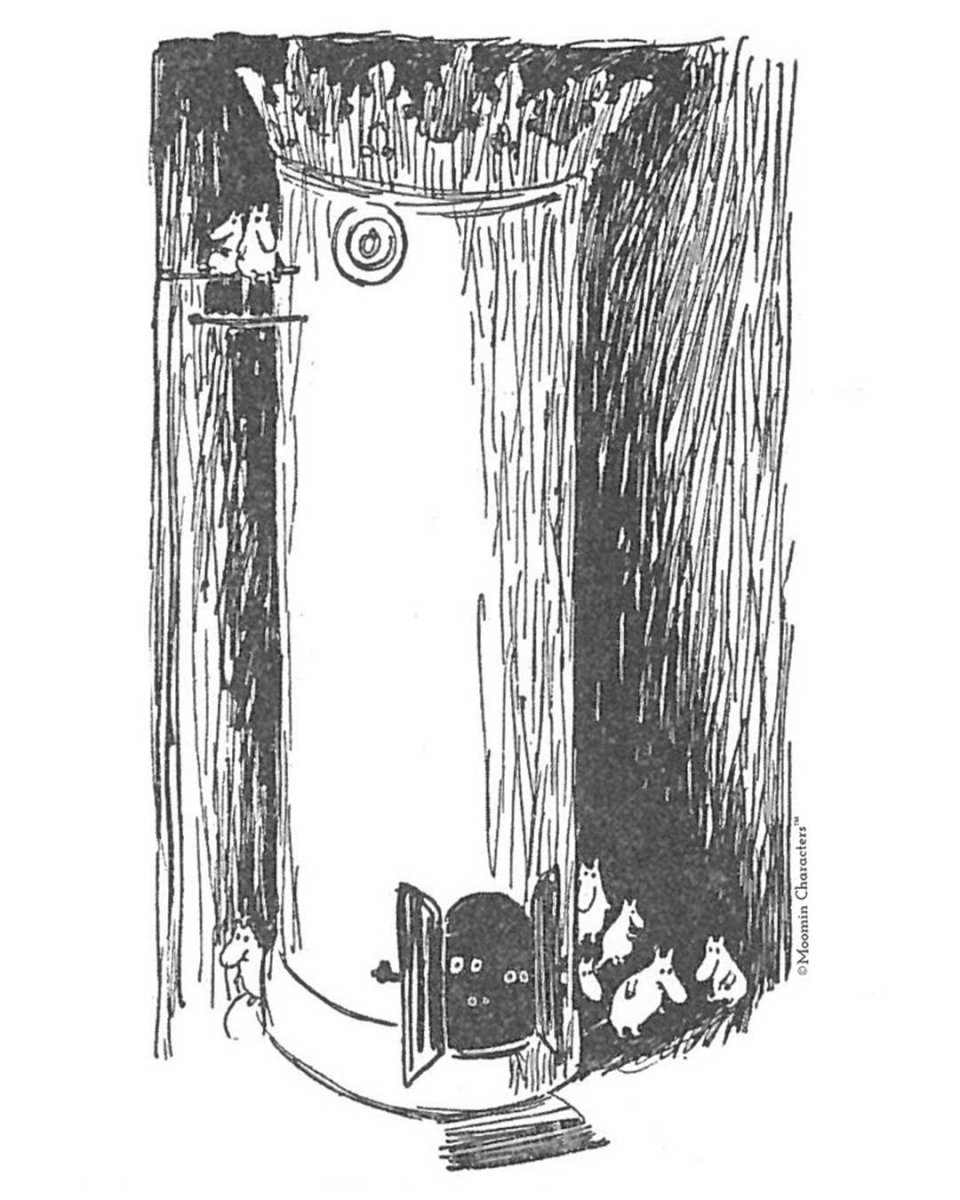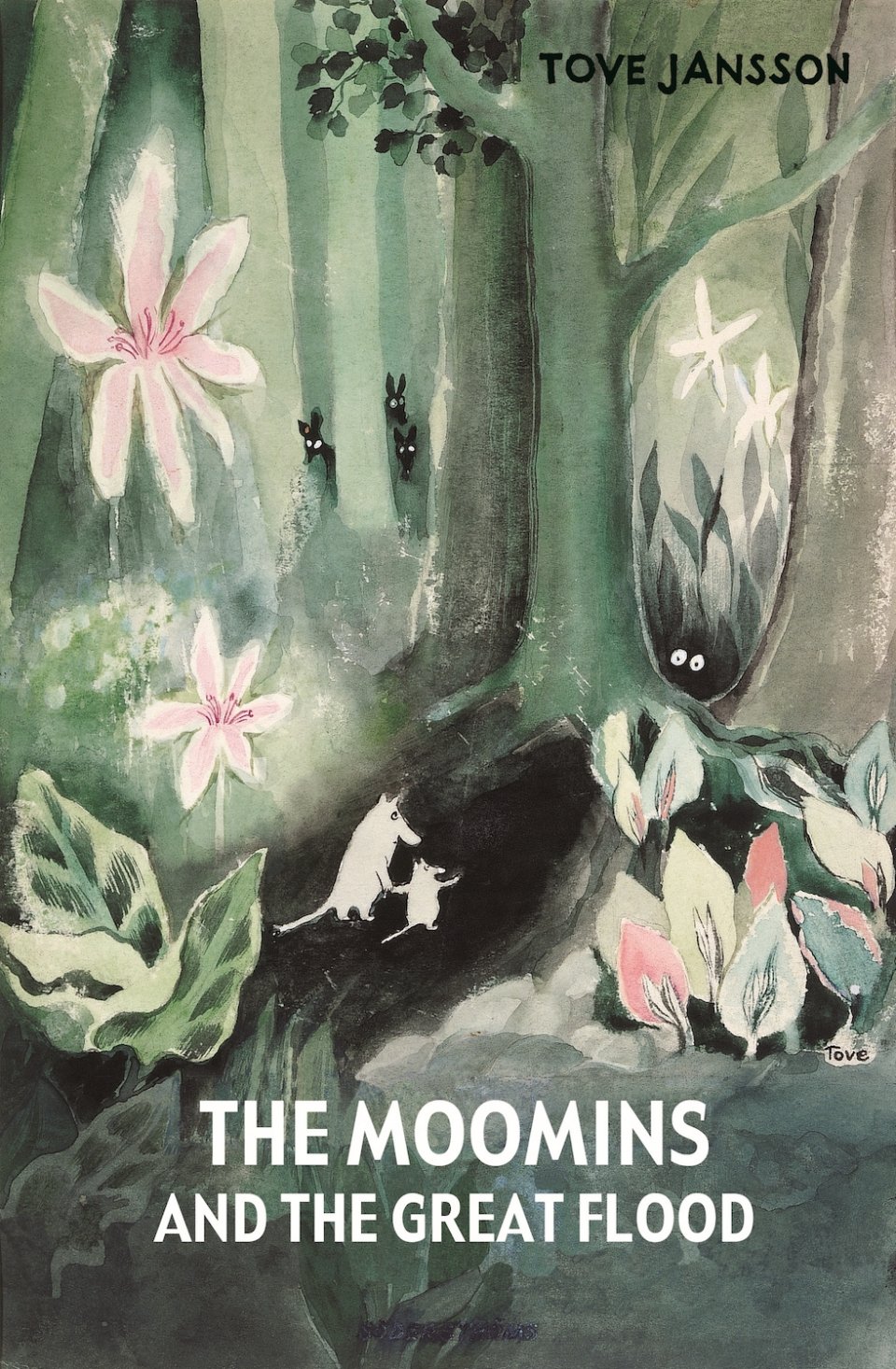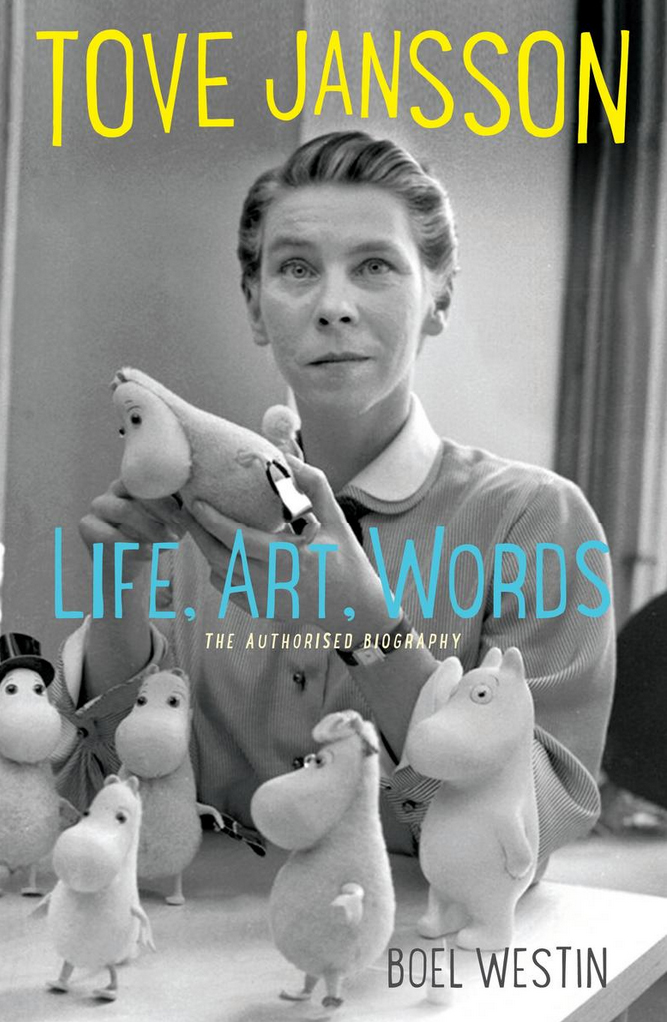The Moomins and the Great Flood, Tove Jansson's first Moomin story, was published in 1945. It presents the characters and themes for which Tove Jansson would later become internationally renowned and contains a good bit of Moomin history.
“At last they came to a small valley that was more beautiful than any they had seen that day. And there, in the midst of the meadow, stood a house that almost looked like a stove, very elegant and painted blue.”
These are the first enchanting words written about Moominvalley and the Moominhouse, found at the end of the book The Moomins and the Great Flood (1945) and accompanied by this magical illustration:

To the surprise of many, even though the book is the very first published Moomin story and introduces the Moomins and how they find Moominvalley, it has always had a complex position within the array of the Moomin books. First, it went largely unnoticed by the larger audience, sold only 219 copies during its first year, and was translated into English as late as 2005. Also, the story has been referred to both as the grand “creation myth of moominology”, as well as a prelude to the eight official Moomin novels rather than “an official Moomin book” due to differences in style and content.
In Swedish, the book was named Småtrollen och den stora översvämningen. Småtrollen, ‘little trolls’, was chosen instead of Mumin (Moomin) because the publisher thought Moomin is too imaginative and would drive all the readers away.
Nevertheless, the book presents an early version of Moomintroll and the characters and themes for which Tove Jansson would later become internationally renowned, and it shines a light on how her ideas and artworks evolved as she developed the Moomin themes and series.
First glimpse of the history and the future of the Moomins
The Moomins and the Great Flood is a story about Moominmamma and Moomintroll’s quest to find the lost Moominpappa who has gone off with the Hattifatteners, and how they find their way to the beautiful Moominvalley, born as a result of a great flood. They move through a forest full of suspense and a monumental flood, counter a stream of surprises and meet all kinds of peculiar beings along the way, including the Hemulens and the Hattifatteners and a “little creature” who, in fact, is an early Sniff who joins them for the journey.

Indeed, the book contains a good bit of Moomin history. For example, in the story, Moominmamma tells Moomintroll how Moomins used to live behind tall stoves in people’s houses and were driven out by the advent of central heating:
“‘Some of us still live there now, I’m sure,’ said Moominmamma. ‘But only where people still have stoves, I mean. We’re not happy with central heating.’”
Psst! This probably explains why the Moomins like to live in tower-like structures.
The book also introduces some of the Moomins’ fundamental traditions, such as the one of hibernating from November to April, later described in Finn Family Moomintroll like this:
“This is a good idea, too, if you don’t like the cold and the long winter darkness.”
Tove Jansson was already a respected artist when her first book was published in 1945. This can be seen in the way she illustrated the first Moomin adventure with a skilful mix of delicate sepia watercolour and delightful pen and line ink drawings.
The realities of the war motivated Tove Jansson to create Moominvalley
The first words written about Moominvalley, quoted at the beginning of this text, reveal that one cannot fully understand The Moomins and the Great Flood and its deepest tones and layers without understanding the time and the world Tove Jansson created it in. The magic in discovering the safe and beautiful Moominvalley comes from the contrast, the uncertainty that defined the flood, and the quest to find Moominpappa.
“She felt that the war had taken all the colours away.”

Tove Jansson wrote the first Moomin story during the hopeless times of the Winter War, fought between Finland and the Soviet Union from 1939-1940. She felt that the war had taken all the colours away, and she needed to write something that ended on a happy note, so the story became a form of escape from the dark shadows of war.
Danger, threats, and fears are present in the first book, like they were present in people’s lives while the book was written. Loss and sorrow, but also the hope of a better future, were the realities of war. The book has been seen as a story of disaster and survival but also as a story of a family, how it grows and is formed, and how the family finds their way to a safe and wonderful home.
Many Moomin researchers say that the horrors of that time served as an inspiration for the Moomin books: Moominvalley served as an alternative world to the world Tove Jansson was living in – a place where one could feel safe, accepted and loved.
Watch this mini-documentary about the book to learn more the book The Moomins and the Great Flood:
80 years of Moomin stories

The Moomins and the Great Flood was published in 1945, which means that 2025 marks 80 years of Moomin stories. Sort Of Books has published a special anniversary edition of The Moomins and the Great Flood which includes a full-colour cut-out Moomin house designed by Tove Jansson in the 1950s plus her notes on the Moomins. The anniversary edition also includes a foreword by Frank Cottrell-Boyce. The anniversary edition is also available in Finnish and Swedish.
Further reading
After The Moomins and the Great Flood, eight Moomin novels followed along with three picture books and a long series of syndicated cartoon strips. Even though The Moomins and the Great Flood didn’t reach high popularity, the next Moomin book, Comet in Moominland, was published already in 1946. Writing and drawing Moomin stories gave Tove a new vent for expressing herself.
One of the most comprehensive sources for background information on the Moomins, Tove Jansson and her life’s work is Boel Westin’s book Tove Jansson: Life, Art, Words, which is an authorised biography published first in Swedish in 2007 and in English in 2014.

The book draws together the many threads of Tove Jansson’s life: from the studies interrupted to help her family, the bleak war years and her emergence as an artist with a studio of her own to the years of Moomin-mania and later novel writing.
“Love and work” was the motto she chose for herself, and her approach to both was joyful and uncompromising, and the book shows how her work reflected these tenets of her life.
Learn more about the other Moomin books:

The shadow of war in the first Moomin story – watch the mini documentary
How much has the war influenced Tove Jansson’s first Moomin story? And what can it teach us on how family can also be chosen?

The touching story behind Who Will Comfort Toffle
Did you know that Tove Jansson’s iconic picture book Who Will Comfort Toffle was inspired by a letter from a young reader? The backstory:

The first Moomin picture book was a praised breakthrough – how did Tove Jansson do it?
Curious about the first Moomin picture book? Watch our short documentary about the Book about Moomin, Mymble and Little My.
